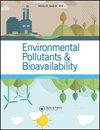腐殖质种群退化及其对耕地土壤中磷形态的影响——以乌克兰森林草原带为例
Q3 Chemical Engineering
引用次数: 6
摘要
摘要土壤腐殖质降解加强了养分的开采,尤其是磷的开采。这项研究是在乌克兰森林-草原区进行的。共对21个土壤剖面进行了调查,其中11个为棕壤,6个为露壤,4个为黑钙土。测试了土壤的粒径分布、碳酸钙(CC)、pH和有机碳(Corg)。根据腐殖质存量差(HSG)、腐殖质稳定性指数(S)和产量差/增益比(YG/G)等指标评价腐殖质退化对磷耗损的影响。为了评价磷的耗竭程度,测定了总磷(Ptot)及其5个组分:水溶性- PH2O、交换性- PEX、结合Fe和Al - PFe/Al、结合Ca - PCa和残余P - Pres。数据显示,在21个被调查土壤中,有14个土壤S指数低于阈值9,其值被认为是腐殖质相对于土壤质地的平衡含量。其次,在21个案例中,有11个案例的负腐殖质平衡表明Phaeozems和Chernozems的产量差距。Phaeozems的前三个P池(PH2O、PEX和PAl/Fe)已经耗尽,占ppt的比例不到10%。Phaeozems、PAl/Fe、Luvisols、PEX和Chernozems中PH2O分数是速效磷状态的基本指标。它们的池受到PCa的直接或间接控制。腐殖土和黑钙土腐殖质含量是影响全磷和有效磷资源的关键因素。改善土壤磷素耗竭需要以恢复土壤腐殖质存量为重点,并配合施用磷肥。本文章由计算机程序翻译,如有差异,请以英文原文为准。
Humus stock degradation and its impact on phosphorus forms in arable soils – a case of the Ukrainian Forest-Steppe Zone
Abstract Soil humus degradation strengthens nutrient mining, especially phosphorus. This study was carried out on the Ukrainian Forest-Steppe Zone (UFSZ). A total of 21 soil profiles have been investigated: 11 Phaeozems, 6 Luvisols, and 4 Chernozems. Soils were tested for particle size distribution, calcium carbonate (CC), pH, and organic carbon (Corg). The evaluation of humus degradation as a reason of P depletion was performed based on indicators such as Humus Stock Gap (HSG), Humus Stability Index (S), and Yield Gap/Gain (YG/G). In order to evaluate the degree of P depletion, total phosphorus (Ptot) and its five fractions: water soluble – PH2O, exchangeable – PEX, bound to Fe and Al – PFe/Al, bound to Ca – PCa, and residual P – Pres, have been determined. Data revealed that in 14 of 21 investigated soils, S indices were below the threshold its value of nine, considered as the balanced content of humus with respect to soil texture. Next, in 11 of 21 cases, the negative humus balance indicates the yield gap in Phaeozems and Chernozems. The first three P pools (PH2O, PEX and PAl/Fe) in Phaeozems were exhausted, constituting less than 10% of the Ptot. In Phaeozems, PAl/Fe, in Luvisols, PEX, and in Chernozems, PH2O fractions were basic indicators of available P status. Their pools were directly or indirectly controlled by PCa. Humus content in Phaeozems and Chernozems revealed as the key factor impacting both total P and/or its available resources. Amelioration of P depletion requires efforts oriented on restoration of soil humus stock, concomitant with P fertilization.
求助全文
通过发布文献求助,成功后即可免费获取论文全文。
去求助
来源期刊
CiteScore
1.62
自引率
0.00%
发文量
0
审稿时长
1 months
期刊介绍:
Chemical Speciation & Bioavailability ( CS&B) is a scholarly, peer-reviewed forum for insights on the chemical aspects of occurrence, distribution, transport, transformation, transfer, fate, and effects of substances in the environment and biota, and their impacts on the uptake of the substances by living organisms. Substances of interests include both beneficial and toxic ones, especially nutrients, heavy metals, persistent organic pollutants, and emerging contaminants, such as engineered nanomaterials, as well as pharmaceuticals and personal-care products as pollutants. It is the aim of this Journal to develop an international community of experienced colleagues to promote the research, discussion, review, and spread of information on chemical speciation and bioavailability, which is a topic of interest to researchers in many disciplines, including environmental, chemical, biological, food, medical, toxicology, and health sciences.
Key themes in the scope of the Journal include, but are not limited to, the following “6Ms”:
Methods for speciation analysis and the evaluation of bioavailability, especially the development, validation, and application of novel methods and techniques.
Media that sustain the processes of release, distribution, transformation, and transfer of chemical speciation; of particular interest are emerging contaminants, such as engineered nanomaterials, pharmaceuticals, and personal-care products.
Mobility of substance species in environment and biota, either spatially or temporally.
Matters that influence the chemical speciation and bioavailability, mainly environmentally relevant conditions.
Mechanisms that govern the transport, transformation, transfer, and fate of chemical speciation in the environment, and the biouptake of substances.
Models for the simulation of chemical speciation and bioavailability, and for the prediction of toxicity.
Chemical Speciation & Bioavailability is a fully open access journal. This means all submitted articles will, if accepted, be available for anyone to read, anywhere, at any time. immediately on publication. There are no charges for submission to this journal.

 求助内容:
求助内容: 应助结果提醒方式:
应助结果提醒方式:


